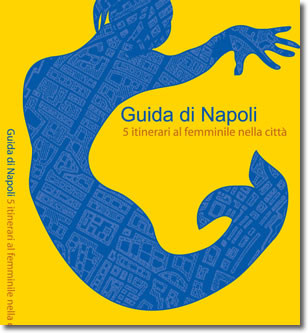

"a real journey is not about seeing new places,
but in seeing with new eyes"
Marcel Proust

The "ParteNopea e ParteDonna" guide contributes to a new interpretation of knowledge of the city of Naples seen through different eyes - eyes which give visibility and significance to a different aspect, the signs impressed on the city by the figures of women who have participated in every step of its historical process.
The irony of the words of the great Totò present to both women and men visitors an unusual vision of the urban structure, the Partenopean city, where the places are associated also with women, with that "woman's part" which have given them a different character, for it is only by recomposing in this way that the extraordinary wealth of the real Naples can be appreciated

It is well known that history is made by the winners. Similarly, the history of cities is told by those who have been its protagonists. Following a code of custom, the stories of cities and their monuments are by guides associating them with the actions and the experiences of those who lived in the palazzi and who are represented in sculptures and paintings.
These protagonists, naturally, are always men.
The spotlight of history has almost never shone on women, to reconstruct their personality, recount their actions, giving them their rightful place. But over a period of twenty centuries, women were present, and significantly so. They have too often been left in the shadows or relegated to the shadows my a male reading of events. The modest "mission" of this guide is, then, to put the spotlight on women protagonists of the history of the city and recount some of it from this point of view. The women's side of Naples, as we can call it, is witnessed by the presence of extraordinary women, poets, journalists, artists, architects, philanthropists, who had contributed to the greatness of the city ...
The city is the first material and symbolic place which establishes the forms of social inclusion and exclusion, the forms of delimitation of citizenship, of definition of the confines between public and private. For a long time, in the city, democracy andaccess to political action, which have been enjoyed by some groups, have been founded on the exclusion of many others among whom women - ever since the beginnings of human history.
"The city is an organised memory", says Hannah Arendth, and "women have been forgotten by history". Citizenship always corresponds with the publicspaceof the city and women, who are excluded from it, are the invisible society of which there is no memory, of which not even the slightest traces are observed even if they could reveal lives and events which have contributed significantly to the history of places.
Rereadingand re-interpreting urban spaces through the signsleft by feminine subjectivity is both useful and necessary, then, if we are to know the whole history of a city, but even moreso in order to restore a memory above all to young women forced to look at and recognise themselves in "another" memory which offers only vicarioous identity.
By means f this guide, URBANIMA, an area of research for temporal policies, sustainable development, security and urban quality, in the frame work of the Interdepartmental Centre for research I.U.P.T. of the University of Naples "Federico II", offers a modest contribution by suggesting different interpretative paradigms of the Neapolitan area.